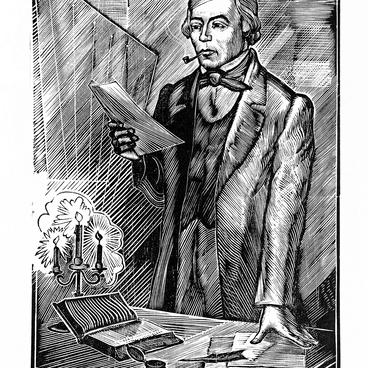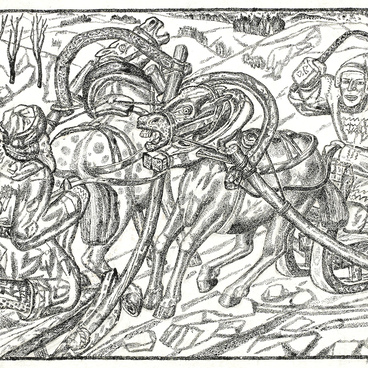Vitaly Fyodorovich Dobrynin was an Honored Worker of Culture of the Republic of Karelia. He was a laureate of various prestigious awards, including the Lenin Komsomol Prize and the international association “The Kalevala Society”. He was exhibiting his works from 1980 and became a member of the Russian Union of Artists in 1986. Vitaly Dobrynin was born in the village of Ukhta, now known as Kalevala. His parents hailed from the Karelian village of Munankilahti. After graduating from the Art and Graphics Faculty of Alexander Herzen Pedagogical Institute in Leningrad in 1980, Dobrynin returned to his small homeland. In the town of Kostomuksha, he established and led a children’s art school.
In his artworks, Vitaly Dobrynin always reflected on the national culture, particularly the epic poem “Kalevala”. His art captures the memory of his homeland and its people. Hence, the artist is often called “the singer of the Kalevala land”.
It is believed that the name “Wainamoinen” (Väinämöinen) originates from the ancient word “vaino” (väinä), which means “a wide and calmly flowing section of a river near its mouth”. In the artwork on display, Vitaly Dobrynin depicts Wainamoinen as calmly gliding on the waves. The close-up and Wainamoinen’s expressive facial features and intense gaze convey a powerful energy that captivates and attracts the viewer. In the colors on the canvas, one can hear the sound of the kantele, the gentle murmur of water, and the sound of wind as it disperses the waves.
The diptych is dedicated to the story of the relationship between Wainamoinen and Youkahainen. Youkahainen harbors a grudge against Wainamoinen, the old sorcerer, and sets a trap for him on his journey to Pohyola (Pohjola). As Wainamoinen crosses the river on his horse, Youkahainen shoots an arrow at him. The arrow hits the horse and Wainamoinen falls into the water. The strong wind carries him out to sea, and Youkahainen thinks that he is victorious, believing that this is the end for Wainamoinen. However, the Sage is able to stay afloat, drifting on the waves under the stars.
The left panel of the diptych features a large
eagle extending its wings. It assists Wainamoinen, taking him onto its back and
carrying him to the shore. The motif of the eagle’s assistance, who is grateful
for the birch tree that Wainamoinen has left for birds when clearing the forest
for arable land, serves as just one example of the interaction between a human
and nature in this epic poem.


